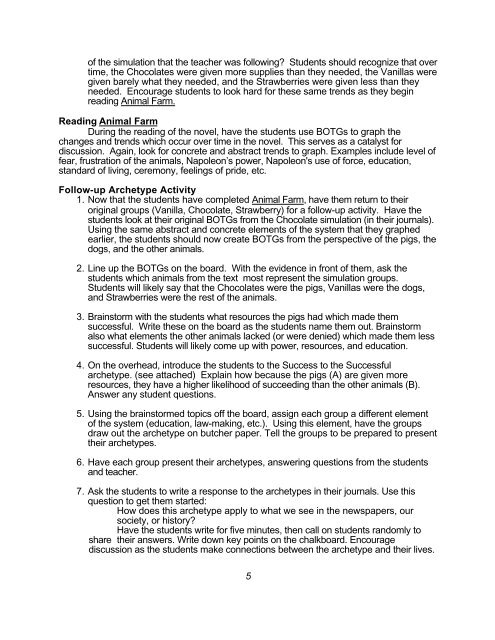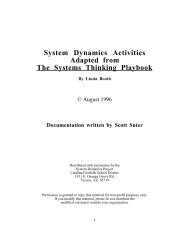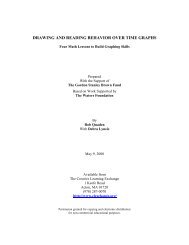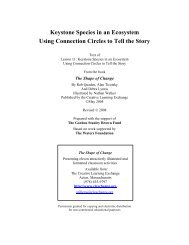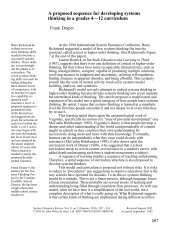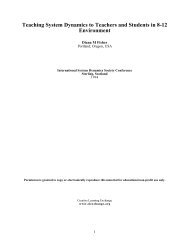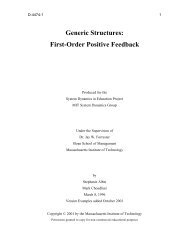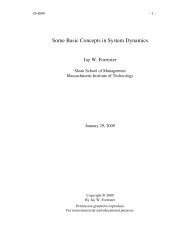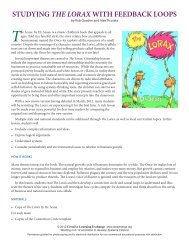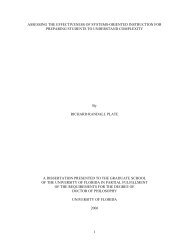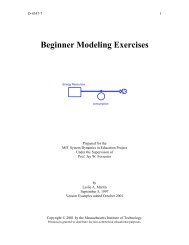An Animal Farm Physical Simulation
An Animal Farm Physical Simulation
An Animal Farm Physical Simulation
- No tags were found...
You also want an ePaper? Increase the reach of your titles
YUMPU automatically turns print PDFs into web optimized ePapers that Google loves.
of the simulation that the teacher was following? Students should recognize that overtime, the Chocolates were given more supplies than they needed, the Vanillas weregiven barely what they needed, and the Strawberries were given less than theyneeded. Encourage students to look hard for these same trends as they beginreading <strong>An</strong>imal <strong>Farm</strong>.Reading <strong>An</strong>imal <strong>Farm</strong>During the reading of the novel, have the students use BOTGs to graph thechanges and trends which occur over time in the novel. This serves as a catalyst fordiscussion. Again, look for concrete and abstract trends to graph. Examples include level offear, frustration of the animals, Napoleon’s power, Napoleon's use of force, education,standard of living, ceremony, feelings of pride, etc.Follow-up Archetype Activity1. Now that the students have completed <strong>An</strong>imal <strong>Farm</strong>, have them return to theiroriginal groups (Vanilla, Chocolate, Strawberry) for a follow-up activity. Have thestudents look at their original BOTGs from the Chocolate simulation (in their journals).Using the same abstract and concrete elements of the system that they graphedearlier, the students should now create BOTGs from the perspective of the pigs, thedogs, and the other animals.2. Line up the BOTGs on the board. With the evidence in front of them, ask thestudents which animals from the text most represent the simulation groups.Students will likely say that the Chocolates were the pigs, Vanillas were the dogs,and Strawberries were the rest of the animals.3. Brainstorm with the students what resources the pigs had which made themsuccessful. Write these on the board as the students name them out. Brainstormalso what elements the other animals lacked (or were denied) which made them lesssuccessful. Students will likely come up with power, resources, and education.4. On the overhead, introduce the students to the Success to the Successfularchetype. (see attached) Explain how because the pigs (A) are given moreresources, they have a higher likelihood of succeeding than the other animals (B).<strong>An</strong>swer any student questions.5. Using the brainstormed topics off the board, assign each group a different elementof the system (education, law-making, etc.). Using this element, have the groupsdraw out the archetype on butcher paper. Tell the groups to be prepared to presenttheir archetypes.6. Have each group present their archetypes, answering questions from the studentsand teacher.7. Ask the students to write a response to the archetypes in their journals. Use thisquestion to get them started:How does this archetype apply to what we see in the newspapers, oursociety, or history?Have the students write for five minutes, then call on students randomly toshare their answers. Write down key points on the chalkboard. Encouragediscussion as the students make connections between the archetype and their lives.5


